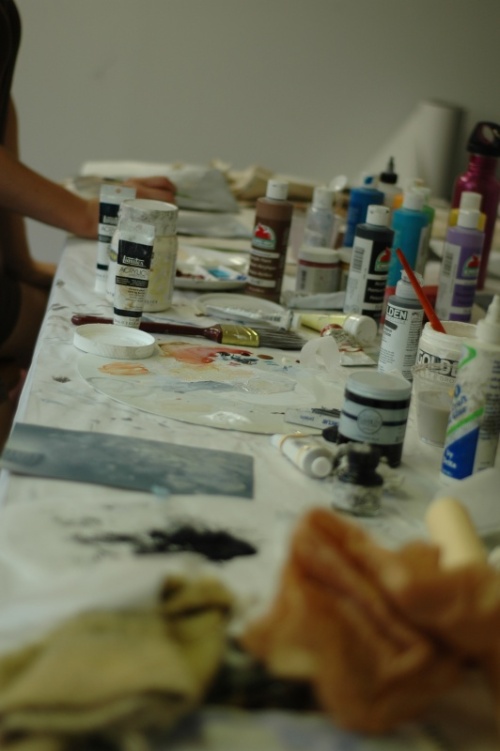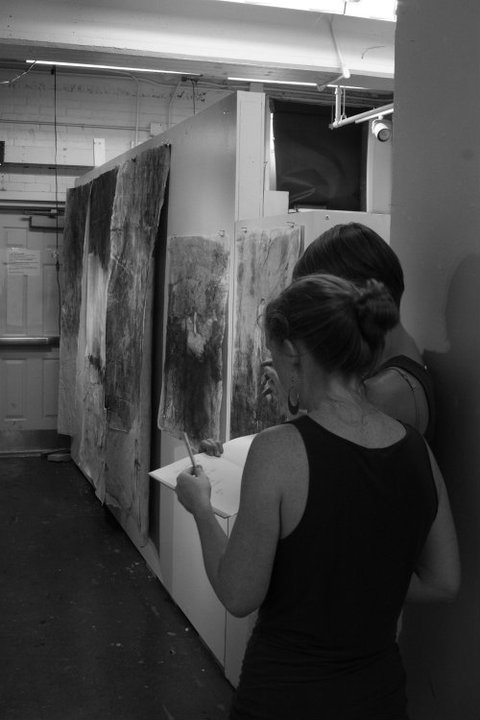Plying Thoughts
October 25, 2011
gallery talk
by Erin
After a special request, Kalina Winska and I are delighted to announce we’ll be giving an informal artist talk in the gallery on Friday at noon. Please join us as we share a bit about the processes and concepts behind the work as well as how we set up successful parameters for collaboration.
Friday, October 28th
12-1pm
“the gallery”
Rietz Union 2nd Floor
Parking is admittedly tricky that time of day, but if you aren’t a student with a parking pass, there are metered spots in the garage next to the Rietz.
October 14, 2011
Upcoming Show
by Erin

Plying Thoughts presents both individual and collaborative artworks by Erin Curry and Kalina Winska. They began working together this past summer based on a kinship between their art practices and personalities. The title of the show refers to the dialogue between them and how the connection manifests itself in collaboration.
In the show, Kalina and Erin also present themselves as two distinct personalities with independent artistic visions through their individual works.
Erin Curry currently lives and works in Gainesville, FL. Her recent work revolves around handspinning raw chaotic fiber into orderly line and shaping ordered line into tangled or woven mass. The thread preserved within the work, either as the object itself or the record of it, functions as a gesture of archetypal human creation as well as shorthand for spun stories of personal narrative, highlighting our complex, often ineffable, relationship to the world around us. She received her BFA in Sculpture at the University of Florida. For more information, please visit the artist’s website at www.erincurry.com.
Kalina Winska, artist from Poland and currently an MFA student in Drawing/Painting Program at University of Florida, creates large-scale drawings and installations. In her art she draws upon loss and the threshold of displacement. Interpreting this liminal state through the transformation of materials, objects, and familiar images that often come from personal memory and Polish Folklore, lies at the core of her studio practice. For more information, please visit the artist’s website at www.kalinawinska.com.
September 2, 2011
Exchange III
by Erin
A few months after we began, I came across Tom Hart’s blog post on collaborative work where he outlines the YES AND principle,”The guiding principle of improvisation in acting and comedy is YES AND… This means AGREEING to the previous ideas and images (“YES”), and ADDING to them (“AND”). He goes on to praise a successful collaboration pointing out, “No one stepping on each other’s toes, every artist respecting the choices of the previous one, each artist making the previous one look good by adding to their ideas.”
This is central to the struggle and joy of working with another voice in the room. Working together means amplifying the strongest moves in the work while allowing the weakest parts to fade away towards ambiance.
July 30, 2011
Exchange II
by Erin
A rhythm developed
kalina: a spray of paint over a paper cut
erin: a print of thread
k: a particular mark made with a brush
e: a drawing of a ball of twine fished from below my studio table
k: a line of beads painted in
e: a smudge of white
a graphite splash
a prismacolor line repeated across the page
tracing paper softening the layers beneath
on and on
Through this process, a kind of game developed. Visual challenges arose that we would never have created for ourselves individually: How do you respond to a saturated chromatic language when monochrome tends to be your vocabulary? or cope with a faint printed line when boldness is needed in this area? Our visual motifs and the language of abstraction combined in surprising ways. Beads twined with strands of strings. Cut paper contrasted with washes of ink. A void spurt forth objects and marks to consider.
Our visual motifs and the language of abstraction combined in surprising ways. Beads twined with strands of strings. Cut paper contrasted with washes of ink. A void spurt forth objects and marks to consider.
We began approaching the same things in different ways, remaking and merging the motifs of our collaborator.
July 23, 2011
Exchange I
by Erin
Kalina and I approached the first part of our collaboration with an intense artist residency of sorts. We met in my studio every morning for a couple of weeks at the beginning of summer and spent a number of hours together before splitting off to tend our individual studio work (or jobs) in the afternoon.
 At first, although we knew we wished to make work together, we weren’t certain of what form our artwork would take, or even the direction we should follow. Rather than defining a specific goal in the beginning, we approached the first weeks with a batch of small works on paper no larger than 8 x 11″ which we exchanged back and forth across the table. We each brought material remnants and supplies from our studio practices and pulled traces of them into the conversation as we gained momentum. These small works allowed us to be spontaneous and develop a visual vocabulary very quickly. The process might be said to be akin to chatting back and forth over coffee, and indeed many of our early mornings were fortified with coffee and scones.
At first, although we knew we wished to make work together, we weren’t certain of what form our artwork would take, or even the direction we should follow. Rather than defining a specific goal in the beginning, we approached the first weeks with a batch of small works on paper no larger than 8 x 11″ which we exchanged back and forth across the table. We each brought material remnants and supplies from our studio practices and pulled traces of them into the conversation as we gained momentum. These small works allowed us to be spontaneous and develop a visual vocabulary very quickly. The process might be said to be akin to chatting back and forth over coffee, and indeed many of our early mornings were fortified with coffee and scones.
July 19, 2011
what does collaboration look like?
by Erin
Kalina and I met only last summer through a mutual professor and immediately felt a kinship between our art practices and personalities.
Soon after, we began to visit each other’s studios to enjoy other’s energy, and exchange ideas, techniques and feedback. When Kalina revealed to me that she was beginning to explore paper and wax in her work, I invited her to my studio to show her some of my previous experiments and give her samples of materials I’d gathered over the years. The little packet I made for her was soon bursting with tidbits of studio ephemera: gampi (silk mulberry paper), snatches of fibers, mulberry bark, Tyvek, insignia cloth, waxes and resins, along with recipes, sources, books, notes and a heat gun. She waited patiently while I found the proper string to tie the packet together and teased as she left saying I was an urban artist shaman sending her home with a medicine pouch.
When she left my doorstep I felt full of inspiration, reinvigoration for some of my own ideas that I’d discussed with her and wished to pursue. It’s remained the same each time we’ve met since.
Weeks later when we met again, Kalina had spliced some of those tiny grains of possibility I’d give to her along with seeds she’d found elsewhere to the root of her own work in cultivating new large drawings with wax and sculptural pieces of melted Tyvek.
Friendship, professional exchange, critical evaluation and conversation: does this function as collaboration in the broadest sense already?
Though I ask the question, I do not believe it an accurate definition of collaboration. However vital this kind of cooperative support remains to engaged art making, the goal of helping each other create better work is too broad to be considered true collaboration. Kalina agrees and expands:
“I think that collaboration is something more, or maybe more specific. Collaboration relies on a bond or connection between people bringing their personal experiences, different ideas, and distinctive modes of labor to build. The root of the word collaboration, lies with the Latin con- (“with”) + labōrō (“work”), is WORK which means a mutual act, a sort of exchange of actions that happens between at least two individuals to create something. Also, I would suggest that those actions must ultimately be in response to the other’s actions. This process requires that each one be attentive and involved in the “labor” conversation as much as each one would be in the monologue character of one’s individual work. In collaboration we have one goal, and even though there are different approaches, they become combined into one joined effort toward that goal.”
April 11, 2011
in collaboration
by Erin
Artists, Kalina Winska and Erin Curry, recently embarked on an investigative collaboration in preparation for a dual show in October of 2011. This blog is the record.
Erin Curry is an American artist who currently lives and works in Gainesville, FL. Her most recent research and art revolves around handspinning raw chaotic fiber into orderly line and shaping ordered line into tangled or woven mass. Immersed in this investigation she contemplates the elemental practice of handspinning, the relationship of craft to art, the signature of human and machine facture, and the ever increasingly tangled connections between things. She received her BFA in Sculpture and Art History at the University of Florida. For more information please visit the artist’s website at www.erincurry.com.
Kalina Winska, artist from Poland, currently an MFA student in Drawing/Painting Program at University of Florida, creates large-scale drawings and installations. In her art she draws upon loss and the threshold of displacement. Interpreting this liminal state through the transformation of materials, objects, and familiar images that often come from personal memory and Polish Folklore, lies at the core of her studio practice. For more information please visit the artist’s website at www.kalinawinska.com.










